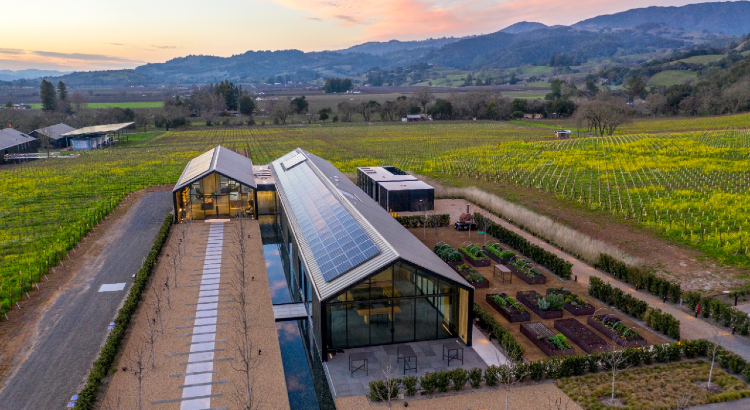A California winery has earned Living Building Challenge certification, making it the largest fully certified building to pass the stringent green building standard.
Silver Oak Cellars vints cabernet sauvignon at the Alexander Valley winery in northern California’s Sonoma County. The project includes a production facility and tasting room totaling 109,122-square-feet set on 113 acres, nearly two-thirds of which are given to vineyards.
As a spokesman for the company described it in an email: “The production facility is really three interconnected buildings that house the cellar, barrel storage, case goods storage, maintenance shop, lab and offices. In addition to the main tasting ‘room,’ the tasting room building contains a wine library, private tasting room, event room and commercial kitchen.”
The winery represents a significant step for the LBC because it’s easily the largest manufacturing plant of any kind to earn certification. Like other Living Building projects, it had to document a full year of operation, while attaining net positive energy and net positive water.
Nearly 3,000 photovoltaic panels on the buildings and on a nearby warehouse and shipping facility generate approximately 1,200 megawatts of power a year. The winery’s significant demand for hot water is met by a combination of thermal solar panels and C02 pumps. And the water-treatment system relies on a membrane bioreactor and ultraviolet light — a promising sustainable solution for water consumption in an industry based in water-strapped California.
An article in Wine Spectator describes the water treatment nicely:
Water used in the winemaking process, for tasks like washing presses and cleaning tanks, is treated with a device called a membrane bioreactor and disinfected with ultraviolet technology and a charcoal filter; it can then be reused to flush toilets and irrigate the vineyards. David Duncan pointed out that the cost of these intricate systems paid off in the long run: Building a conventional wastewater pond would have eliminated 2 acres of land where he instead planted grapevines.
The Alexander Valley winery now uses only 1 gallon of potable water per gallon of wine produced, a rare, possibly unmatched, ratio for a winery (for many, it’s closer to 5, or even 10 gallons of water). “In a region where water scarcity is common, Silver Oak is showing its possible to greatly reduce water demand through innovative practices and technologies,” said Williams.
Alexander Valley is the world’s 25th fully certified LBC project. It’s the second winery to earn Living Building Challenge certification, but it’s much larger than Cowhorn Vineyard in Jacksonville, Oregon, where the certified structure was limited to a 2,200-square-foot tasting room.
The project was shepherded for six years by Silver Oak Sustainability and Safety Manager Haley Duncan, whose family owns the winery. The architect was Piechota Architecture, a boutique firm in San Francsico. Mechanical engineers were Santa Rosa-based TEP, and the general contractor was Cello & Maudru, which also rebuilt the Silver Oak’s Oakville winery after a fire 14 years ago.
More details can be found in Silver Oak’s “certification binder,” which is part of the Living Building Challenge process.
PHOTO AT TOP: The Silver Oak tasting room at the company’s Alexander Valley winery. Photo by John O’Connell.


